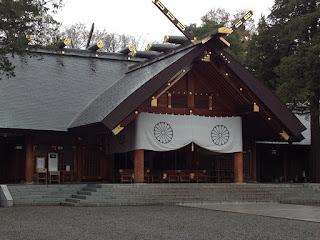Day 4 of our vacation ~ We headed down to Otaru in the late afternoon, a city renowned for its exquisite musical boxes and fine glassware. It was indeed a sight to behold and I just wished I had all the money in the world to buy the cuddly teddy bears, fanciful glass figurines and enchanting musical boxes that came in all shapes and sizes.
Our eyes definitely did not tire from admiring all the art masterpieces but our legs were tired from all that walking. Hence, we took a break at the "Cake Coffee" cafe which sells aromatic coffee in the limited edition Hello Kitty cup. The unique selling point of the cafe was that after enjoying the hot drink, we could wash the cups and bring them home as a souvenir! So now I have a kawaii Hello Kitty cup on my office desk!
After we have rested, we spent some time up in the highest clock tower which oversees the entire Otaru Town. As it was drizzling slightly that day, the atmosphere in the town felt a little sleepy, idyllic and romantic. You may also notice from the photos that the city's architecture is very much like that of any Italian town. Our tour guide explained that as such, there is relatively fewer Westerners visiting Otaru, as they would prefer to travel to Kyushu to visit Japan's historical monuments and experience the Japanese's traditional way of living .
Before leaving, we had an opportunity to watch the glass-maker working at the forge. Shops along the streets of Otaru were also brainwashing visitors to buy a glassware as the perfect Father's Day gift! Haha, of course we weren't so easily fooled.
If I go back to Hokkaido again, I will definitely spend more time to enjoy a leisurely relaxed stroll (and try the 6-flavours ice-cream) in this idyllic place of my dreams!






















































